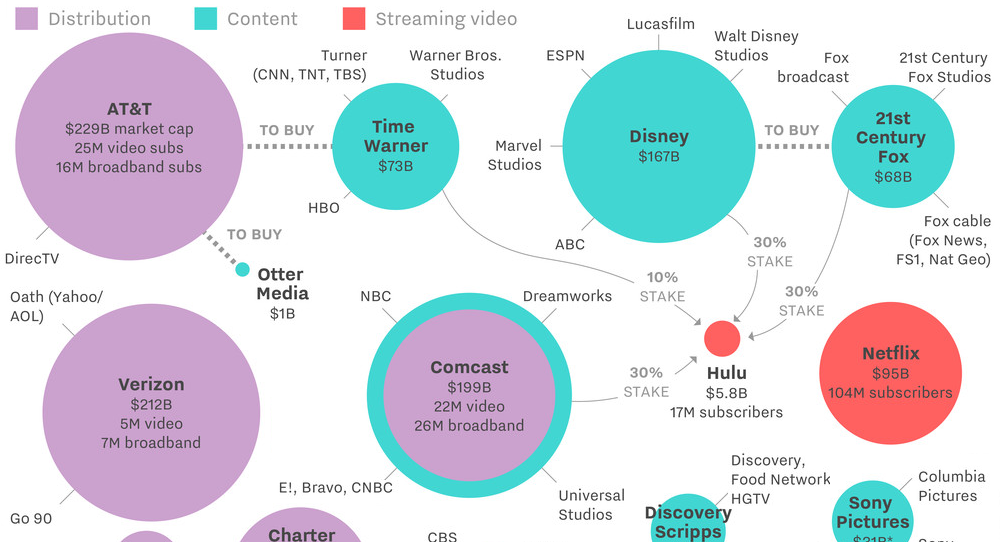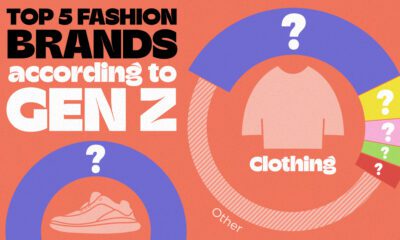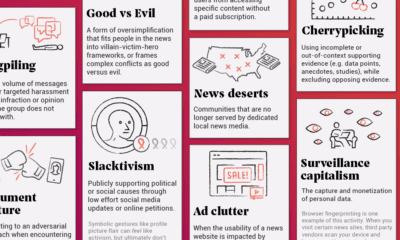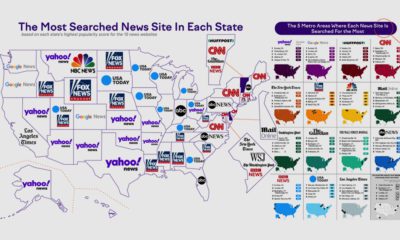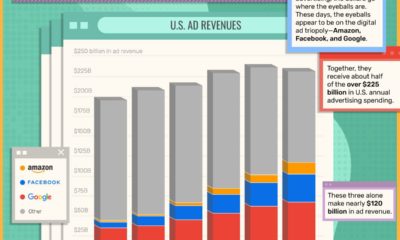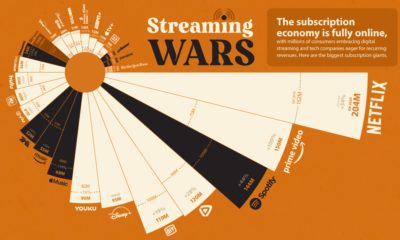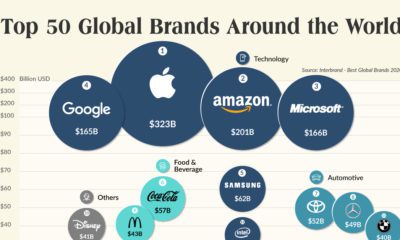Technology
Visualizing the Changing Landscape of Big Media
Big Media is in the middle of a monumental shift.
With immense pressure on revenues, market share, and distribution stemming from platforms and the migration to digital, the traditional big media players are scrambling to find new models and tactics that work.
In addition to forcing companies to evaluate new ways to monetize and distribute content, this industry turmoil has also served up the perfect environment for massive mergers and acquisitions. Big conglomerates aren’t going to go down without a fight, and as a result they are willing to “bet the farm” on M&A to try and compete.
The Big Media Landscape
Today’s visualization comes to us from Recode via media reporters Peter Kafka and Rani Molla, and it does an excellent job in summing up the changing landscape of Big Media.
Notably, it helps visualize the significance of the recent $52.4 billion merger between Disney and 21st Century Fox, as well as the $85 billion merger between AT&T and Time Warner. The latter is set to go to antitrust trials in March.
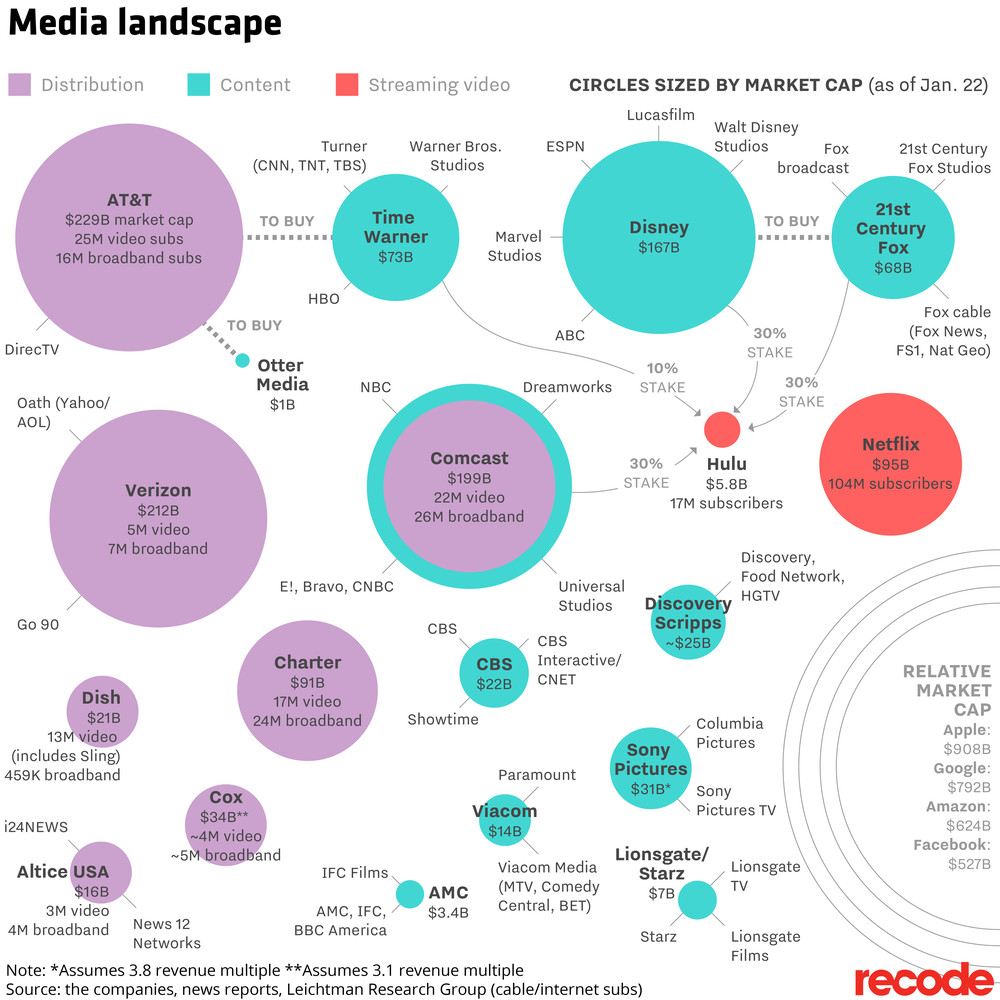
It’s worth noting that the above graphic only shows the big players in the media landscape – and new media companies like Buzzfeed ($1.7 billion valuation) and Vox Media ($1.0 billion) are “too small” to include.
As such, it focuses primarily on the conglomerates that own many different media assets, with a heavy slant towards video content and distribution.
Platform Takeover
The impetus behind much of the turmoil in the media space comes from the unrivaled success of platforms.
Netflix has quickly emerged as a $100 billion+ company, and it already outsizes content stalwarts like Time Warner and 21st Century Fox, which each have histories going back many decades.
In response? In the visualization, you can see the investments made by Disney, Comcast, 21st Century Fox, and Time Warner into video streamer Hulu in one attempt to hedge bets.
But unfortunately, it’s not only Netflix that is a threat – on the advertising side, the Google/Facebook duopoly is wreaking havoc on virtually every online media company in existence. The below graphic, which helps to contextualize the trend in global ad revenue, is from a previous chart we published last year.
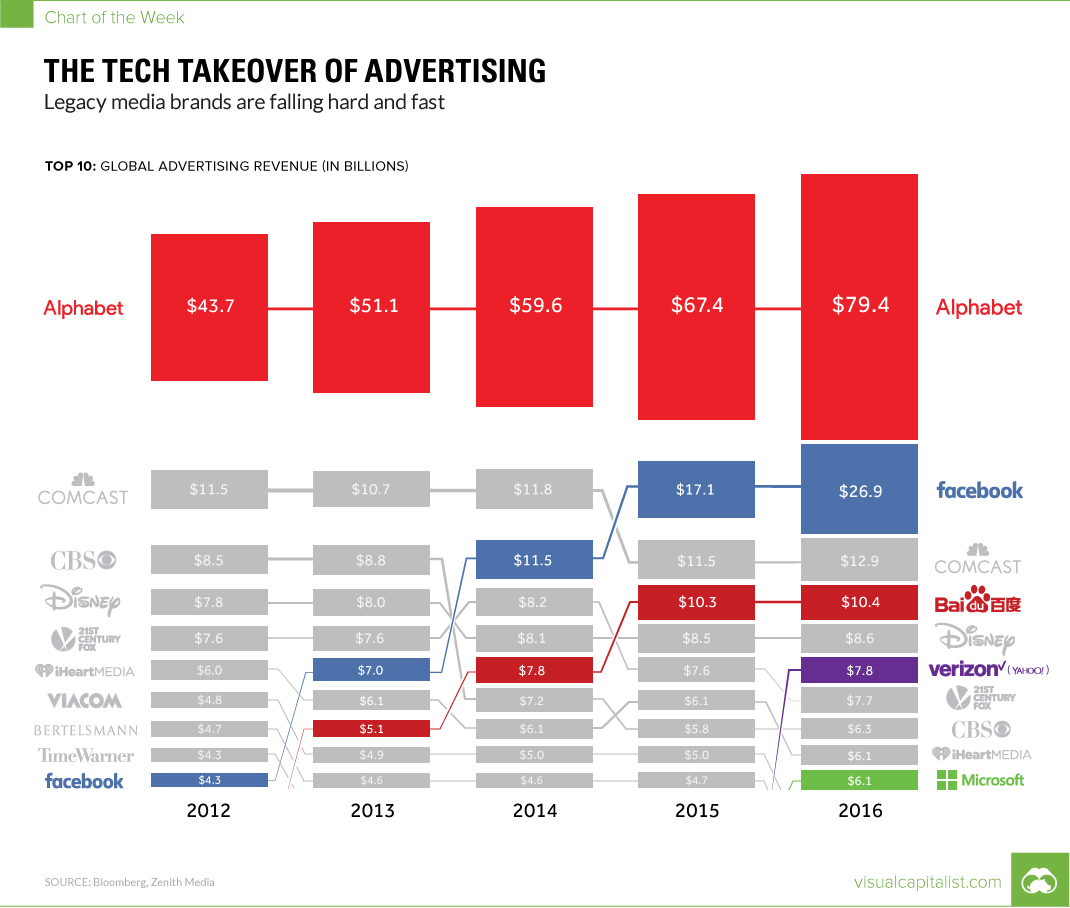
To combat a shrinking share of the pie, even long-running brands like the New York Times are migrating their monetization strategy towards paid subscriptions. In other words, even the Times acknowledges that it can’t compete with the scale and targeting ability of the platforms.
That’s why, unless the dust settles in the near-term, there will be even more consolidation and attempts towards innovation in the media sector. This is especially true for the big conglomerates, who need to show shareholders that they are trying to do something to stop the bleeding.
Technology
Visualizing AI Patents by Country
See which countries have been granted the most AI patents each year, from 2012 to 2022.

Visualizing AI Patents by Country
This was originally posted on our Voronoi app. Download the app for free on iOS or Android and discover incredible data-driven charts from a variety of trusted sources.
This infographic shows the number of AI-related patents granted each year from 2010 to 2022 (latest data available). These figures come from the Center for Security and Emerging Technology (CSET), accessed via Stanford University’s 2024 AI Index Report.
From this data, we can see that China first overtook the U.S. in 2013. Since then, the country has seen enormous growth in the number of AI patents granted each year.
| Year | China | EU and UK | U.S. | RoW | Global Total |
|---|---|---|---|---|---|
| 2010 | 307 | 137 | 984 | 571 | 1,999 |
| 2011 | 516 | 129 | 980 | 581 | 2,206 |
| 2012 | 926 | 112 | 950 | 660 | 2,648 |
| 2013 | 1,035 | 91 | 970 | 627 | 2,723 |
| 2014 | 1,278 | 97 | 1,078 | 667 | 3,120 |
| 2015 | 1,721 | 110 | 1,135 | 539 | 3,505 |
| 2016 | 1,621 | 128 | 1,298 | 714 | 3,761 |
| 2017 | 2,428 | 144 | 1,489 | 1,075 | 5,136 |
| 2018 | 4,741 | 155 | 1,674 | 1,574 | 8,144 |
| 2019 | 9,530 | 322 | 3,211 | 2,720 | 15,783 |
| 2020 | 13,071 | 406 | 5,441 | 4,455 | 23,373 |
| 2021 | 21,907 | 623 | 8,219 | 7,519 | 38,268 |
| 2022 | 35,315 | 1,173 | 12,077 | 13,699 | 62,264 |
In 2022, China was granted more patents than every other country combined.
While this suggests that the country is very active in researching the field of artificial intelligence, it doesn’t necessarily mean that China is the farthest in terms of capability.
Key Facts About AI Patents
According to CSET, AI patents relate to mathematical relationships and algorithms, which are considered abstract ideas under patent law. They can also have different meaning, depending on where they are filed.
In the U.S., AI patenting is concentrated amongst large companies including IBM, Microsoft, and Google. On the other hand, AI patenting in China is more distributed across government organizations, universities, and tech firms (e.g. Tencent).
In terms of focus area, China’s patents are typically related to computer vision, a field of AI that enables computers and systems to interpret visual data and inputs. Meanwhile America’s efforts are more evenly distributed across research fields.
Learn More About AI From Visual Capitalist
If you want to see more data visualizations on artificial intelligence, check out this graphic that shows which job departments will be impacted by AI the most.
-

 Mining1 week ago
Mining1 week agoGold vs. S&P 500: Which Has Grown More Over Five Years?
-

 Markets2 weeks ago
Markets2 weeks agoRanked: The Most Valuable Housing Markets in America
-

 Money2 weeks ago
Money2 weeks agoWhich States Have the Highest Minimum Wage in America?
-

 AI2 weeks ago
AI2 weeks agoRanked: Semiconductor Companies by Industry Revenue Share
-

 Markets2 weeks ago
Markets2 weeks agoRanked: The World’s Top Flight Routes, by Revenue
-

 Countries2 weeks ago
Countries2 weeks agoPopulation Projections: The World’s 6 Largest Countries in 2075
-

 Markets2 weeks ago
Markets2 weeks agoThe Top 10 States by Real GDP Growth in 2023
-

 Demographics2 weeks ago
Demographics2 weeks agoThe Smallest Gender Wage Gaps in OECD Countries
